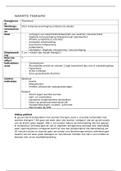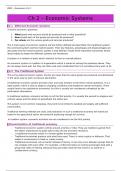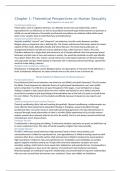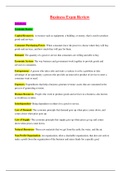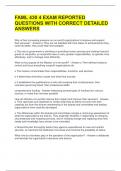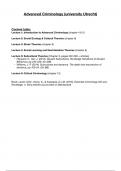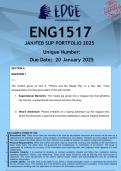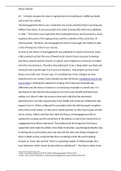Summary – Solomon, M. R. (2020) Consumer Behavior Buying, Having, and Being.
Consumer behavior – Summary
(Period 4)
1.1 What is Consumer Behavior?
The behavior that consumers display in searching for, purchasing, using, evaluating, and disposing of
products and services that they expect will satisfy their needs.
Consumer behavior is interdisciplinary:
people are often not “rational” decision-makers
Limited cognitive capabilities: heuristics, rules of thumb
Emotions and feelings
Making correct predictions on how consumers respond to marketing actions can generate a
lot of money
The 4 P’s:
Product
Price
Place
Promotion
Chapter 1 Buying, having, and being: an introduction to
consumer behavior
1.1 Consumer behavior is a process: people in the marketplace
Target group: knowledge of consumer characteristics plays an extremely important role in
many marketing applications (eg. demographics: age, gender, income or occupations)
Consumers may be influenced by friends, social media or consumption communities (where
members share opinions and recommendations; the group members want to conform to the
others in the group (Gruppenzwang, Mithalten wollen)
Market segmentation strategies: An organization targets its product/ service only to specific
groups of consumers (brands often have clear “Personas” that they want to address
Brand loyalty: When a product/ service meets our specific needs or desires (loyalty is hard to
break by competitors). People like products when they fit to their own personality. There are
many facts that will influence the decision-making-process of a customer: e.g: appearance,
taste, texture, smell, website, packaging, brand name etc.
1.2 What is consumer behavior?
,Summary – Solomon, M. R. (2020) Consumer Behavior Buying, Having, and Being.
Definition: It is the study of the processes involved when individuals or groups select,
purchase, use, or dispose of products, services, ideas, or experiences to satisfy needs and
desires. The needs and desires we satisfy range from hunger and thirst to love, status, and
even spiritual fulfillment (Piramide van Maslow).
Consumer behavior is a process: Consumer behavior is an ongoing process.
1. The exchange: a simple transaction. Two organizations or people give and receive
something of value.
2. Exchange theory: the entire consumption process of a customer (facts that influence him
before, during and after the purchase of a product).
3. Consumer: a person who identifies a need/ desire, makes a purchase, and then disposes
of the product during the 3 stages of the consumption process. There are different
persons in a buyer process: the purchase, the user, influencer etc.
Consumers impact on Marketing Strategy:
Organizations exist to satisfy needs. In order to be able to satisfy these needs, the
organization needs to understand the people who will use the products or services (that is
Consumer behavior).
Dividing markets
Different customers: Marketeers should address a special target group (a market segment).
The most faithful customers are called: heavy users.
Pareto-principle (80/20 rule): 20 percent of users account 80 percent of sales. It’s a kind of
guideline that marketeers are following to identify the heavy users.
Consumer segmentation: Demographics
Statistics that measure observable aspects of a population (there a special data bases that
provide demographical information about age, income etc. of people (CBS, EUROMONITOR
etc.)
1. Age: Consumers of different age groups have different needs, although people who
belong to the same age group differ in many other ways.
2. Gender: Many products target either men or women.
,Summary – Solomon, M. R. (2020) Consumer Behavior Buying, Having, and Being.
3. Family structure: A person’s family and marital status has a huge effect on customers’
spending priorities, e.g.: young people: bars, concerts, alcohol; families: healthy food and
fruit juices.
4. Social class and income: People who belong to the same social class are approximately
equal in terms of income and social standing in the community. They also tend to
socialize with another and share many ideas and values.
5. Race and Ethnicity: As our society becomes increasingly multicultural, new opportunities
develop to deliver specialized products to racial and ethnic groups, e.g.: McDonalds with
offering new menu items.
6. Geography: Consumers who are living in different party of the country. Keep in mind that
also the language can differ, depending on where the people come from (slang).
7. Lifestyles: Consumers have different lifestyles: the way we feel about ourselves, the
things we value in our spare time etc.
Segmenting by behavior: Relationships and “Big Data”
1. Relationship marketing: Marketers carefully define customer segments. The key is to
build a relationship between brands and customers that will last a lifetime.
brands interact with customers on a regular basis and give them solid reasons to
maintain a bond. I good relationship is especially in nasty economic conditions (economic
crisis) important because in times of this people tend to rely on their good old friends
(eg. supporting local shops or brands during lockdown).
Examples: E-Mail Marketing, Netflix relationship management through social media,
personalized accounts (top 10 films that you might be interested in), personalized ads
etc.
Relationships a person might have with a product:
Self-concept attachment—The product helps to establish the user’s identity.
Nostalgic attachment—The product serves as a link with a past self.
Interdependence—The product is a part of the user’s daily routine.
Love—The product elicits emotional bonds of warmth, passion or other strong emotion.
2. Database marketing: it tracks specific customers’ buying habits, e.g.: by GPS, AH bonus
card, Facebook comments etc. The collection and analysis of large datasets is called Big
Data. This information enables companies, the government etc. to make precise
predictions about what products we will buy, what charities we will donate etc.
Example: When they monitor blips in Google queries for words like flu and fever, epidemiologists at
the Centers for Disease Control can identify specific areas of the United States that have been hit by
flu outbreaks even before the local authorities notice a rise in hospital admissions.
Amazon:
Alexa voice recordings Amazon offers virtual assistants. Their audio recordings are being
uploaded to Amazon’s servers
Personalized recommendations system The power of suggestion to encourage impulsive
purchases (“Maybe also these products are interesting for you”)
, Summary – Solomon, M. R. (2020) Consumer Behavior Buying, Having, and Being.
1.3 Marketing’s impact on Consumers
Popular Culture Is Marketing Is Popular Culture …
Marketing stimuli surround us as ads, stores, and products compete for our attention and our
money. Ads show us how we should act with regard to recycling, alcohol consumption, the types of
houses and cars we might wish to own—and even how to evaluate others based on the products
they buy or don’t buy.
Popular culture: the music, movies, sports, books, celebrities, and other forms of
entertainment that the mass market produces and consumes—is both a product of and an
inspiration for marketers. This cultural impact is hard to overlook, although many people do
not seem to realize how much marketers influence their preferences for movie and musical
heroes; the latest fashions in clothing, food, and decorating choices; and even the physical
features that they find attractive or ugly in men and women.
All the World’s a Stage
The sociological perspective of role theory takes the view that much of consumer behavior
resembles actions in a play. The criteria they use to evaluate products and services in one of their
roles may be quite different from those they use in other roles, e.g.: hipsters, geek etc.
What does it mean to consume?
People often buy products not for what they do, but for what they mean, like using candy as
decoration etc. The roles products play in our lives extend well beyond the tasks they perform. The
deeper meanings of a product may help it to stand out from other similar goods and services. All
things being equal, we choose the brand that has an image (or even a personality!) consistent with
our underlying needs, like buying Nikes or Apple. These choices also help each of us to form bonds
with others who share similar preferences.
What do we need really?
Researchers concluded that happiness is linked to satisfying wants and needs, whereas
meaningfulness relates to activities that express oneself and impact others in a positive way. What is
the difference between needing something and wanting it? The answer to this deceptively simple
question actually explains a lot of consumer behavior! A need is something a person must have to
live or achieve a goal. A want is a specific manifestation of a need that personal and cultural factors
determine.
1.4 The Global “Always-On” Consumer
Megacity: a metropolitan area with a total population of more than 10 million people.
This concentration in urban centers, combined with population growth in developing countries
and increasing demands for modernization by billions of people in booming economies such as
China, India, and Brazil, is both a blessing and a curse the economy is booming. On the one
hand people are wealthy, on the other hand some people go to bed hungry. Companies and
customers have a huge impact on our future.
The Digital Native: Living a Social (Media) Life: We are always online (on our smartphones)
and share how our lives are going. The digital revolution is one of the biggest influences on
consumer behavior. With the increasing use of handheld devices and wireless
communications, you can get that same information—from stock quotes to the weather—
even when you’re away from your computer. The cyberspace explosion has created a
revolution in consumer-to-consumer activity (C2C e-commerce): Welcome to the world of
Consumer behavior – Summary
(Period 4)
1.1 What is Consumer Behavior?
The behavior that consumers display in searching for, purchasing, using, evaluating, and disposing of
products and services that they expect will satisfy their needs.
Consumer behavior is interdisciplinary:
people are often not “rational” decision-makers
Limited cognitive capabilities: heuristics, rules of thumb
Emotions and feelings
Making correct predictions on how consumers respond to marketing actions can generate a
lot of money
The 4 P’s:
Product
Price
Place
Promotion
Chapter 1 Buying, having, and being: an introduction to
consumer behavior
1.1 Consumer behavior is a process: people in the marketplace
Target group: knowledge of consumer characteristics plays an extremely important role in
many marketing applications (eg. demographics: age, gender, income or occupations)
Consumers may be influenced by friends, social media or consumption communities (where
members share opinions and recommendations; the group members want to conform to the
others in the group (Gruppenzwang, Mithalten wollen)
Market segmentation strategies: An organization targets its product/ service only to specific
groups of consumers (brands often have clear “Personas” that they want to address
Brand loyalty: When a product/ service meets our specific needs or desires (loyalty is hard to
break by competitors). People like products when they fit to their own personality. There are
many facts that will influence the decision-making-process of a customer: e.g: appearance,
taste, texture, smell, website, packaging, brand name etc.
1.2 What is consumer behavior?
,Summary – Solomon, M. R. (2020) Consumer Behavior Buying, Having, and Being.
Definition: It is the study of the processes involved when individuals or groups select,
purchase, use, or dispose of products, services, ideas, or experiences to satisfy needs and
desires. The needs and desires we satisfy range from hunger and thirst to love, status, and
even spiritual fulfillment (Piramide van Maslow).
Consumer behavior is a process: Consumer behavior is an ongoing process.
1. The exchange: a simple transaction. Two organizations or people give and receive
something of value.
2. Exchange theory: the entire consumption process of a customer (facts that influence him
before, during and after the purchase of a product).
3. Consumer: a person who identifies a need/ desire, makes a purchase, and then disposes
of the product during the 3 stages of the consumption process. There are different
persons in a buyer process: the purchase, the user, influencer etc.
Consumers impact on Marketing Strategy:
Organizations exist to satisfy needs. In order to be able to satisfy these needs, the
organization needs to understand the people who will use the products or services (that is
Consumer behavior).
Dividing markets
Different customers: Marketeers should address a special target group (a market segment).
The most faithful customers are called: heavy users.
Pareto-principle (80/20 rule): 20 percent of users account 80 percent of sales. It’s a kind of
guideline that marketeers are following to identify the heavy users.
Consumer segmentation: Demographics
Statistics that measure observable aspects of a population (there a special data bases that
provide demographical information about age, income etc. of people (CBS, EUROMONITOR
etc.)
1. Age: Consumers of different age groups have different needs, although people who
belong to the same age group differ in many other ways.
2. Gender: Many products target either men or women.
,Summary – Solomon, M. R. (2020) Consumer Behavior Buying, Having, and Being.
3. Family structure: A person’s family and marital status has a huge effect on customers’
spending priorities, e.g.: young people: bars, concerts, alcohol; families: healthy food and
fruit juices.
4. Social class and income: People who belong to the same social class are approximately
equal in terms of income and social standing in the community. They also tend to
socialize with another and share many ideas and values.
5. Race and Ethnicity: As our society becomes increasingly multicultural, new opportunities
develop to deliver specialized products to racial and ethnic groups, e.g.: McDonalds with
offering new menu items.
6. Geography: Consumers who are living in different party of the country. Keep in mind that
also the language can differ, depending on where the people come from (slang).
7. Lifestyles: Consumers have different lifestyles: the way we feel about ourselves, the
things we value in our spare time etc.
Segmenting by behavior: Relationships and “Big Data”
1. Relationship marketing: Marketers carefully define customer segments. The key is to
build a relationship between brands and customers that will last a lifetime.
brands interact with customers on a regular basis and give them solid reasons to
maintain a bond. I good relationship is especially in nasty economic conditions (economic
crisis) important because in times of this people tend to rely on their good old friends
(eg. supporting local shops or brands during lockdown).
Examples: E-Mail Marketing, Netflix relationship management through social media,
personalized accounts (top 10 films that you might be interested in), personalized ads
etc.
Relationships a person might have with a product:
Self-concept attachment—The product helps to establish the user’s identity.
Nostalgic attachment—The product serves as a link with a past self.
Interdependence—The product is a part of the user’s daily routine.
Love—The product elicits emotional bonds of warmth, passion or other strong emotion.
2. Database marketing: it tracks specific customers’ buying habits, e.g.: by GPS, AH bonus
card, Facebook comments etc. The collection and analysis of large datasets is called Big
Data. This information enables companies, the government etc. to make precise
predictions about what products we will buy, what charities we will donate etc.
Example: When they monitor blips in Google queries for words like flu and fever, epidemiologists at
the Centers for Disease Control can identify specific areas of the United States that have been hit by
flu outbreaks even before the local authorities notice a rise in hospital admissions.
Amazon:
Alexa voice recordings Amazon offers virtual assistants. Their audio recordings are being
uploaded to Amazon’s servers
Personalized recommendations system The power of suggestion to encourage impulsive
purchases (“Maybe also these products are interesting for you”)
, Summary – Solomon, M. R. (2020) Consumer Behavior Buying, Having, and Being.
1.3 Marketing’s impact on Consumers
Popular Culture Is Marketing Is Popular Culture …
Marketing stimuli surround us as ads, stores, and products compete for our attention and our
money. Ads show us how we should act with regard to recycling, alcohol consumption, the types of
houses and cars we might wish to own—and even how to evaluate others based on the products
they buy or don’t buy.
Popular culture: the music, movies, sports, books, celebrities, and other forms of
entertainment that the mass market produces and consumes—is both a product of and an
inspiration for marketers. This cultural impact is hard to overlook, although many people do
not seem to realize how much marketers influence their preferences for movie and musical
heroes; the latest fashions in clothing, food, and decorating choices; and even the physical
features that they find attractive or ugly in men and women.
All the World’s a Stage
The sociological perspective of role theory takes the view that much of consumer behavior
resembles actions in a play. The criteria they use to evaluate products and services in one of their
roles may be quite different from those they use in other roles, e.g.: hipsters, geek etc.
What does it mean to consume?
People often buy products not for what they do, but for what they mean, like using candy as
decoration etc. The roles products play in our lives extend well beyond the tasks they perform. The
deeper meanings of a product may help it to stand out from other similar goods and services. All
things being equal, we choose the brand that has an image (or even a personality!) consistent with
our underlying needs, like buying Nikes or Apple. These choices also help each of us to form bonds
with others who share similar preferences.
What do we need really?
Researchers concluded that happiness is linked to satisfying wants and needs, whereas
meaningfulness relates to activities that express oneself and impact others in a positive way. What is
the difference between needing something and wanting it? The answer to this deceptively simple
question actually explains a lot of consumer behavior! A need is something a person must have to
live or achieve a goal. A want is a specific manifestation of a need that personal and cultural factors
determine.
1.4 The Global “Always-On” Consumer
Megacity: a metropolitan area with a total population of more than 10 million people.
This concentration in urban centers, combined with population growth in developing countries
and increasing demands for modernization by billions of people in booming economies such as
China, India, and Brazil, is both a blessing and a curse the economy is booming. On the one
hand people are wealthy, on the other hand some people go to bed hungry. Companies and
customers have a huge impact on our future.
The Digital Native: Living a Social (Media) Life: We are always online (on our smartphones)
and share how our lives are going. The digital revolution is one of the biggest influences on
consumer behavior. With the increasing use of handheld devices and wireless
communications, you can get that same information—from stock quotes to the weather—
even when you’re away from your computer. The cyberspace explosion has created a
revolution in consumer-to-consumer activity (C2C e-commerce): Welcome to the world of


